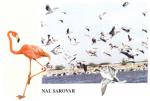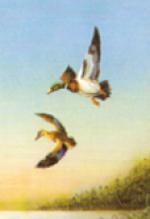Nal Sarovar is the internationally known Wetland of Gujarat. It is situated within the Surendranagar and Ahmedabad districts. It spreads over the area of 115 sq. m. and is 62 km away from Ahmedabad. There are good roads from Viramgam for 30 km or so to reach Nal Sarovar. There is a wellknown lake named Munsur in this area. While Malav talav in Dholka is known for its historical value
Nal Sarovar is an unique wetland. Not only is it vast, it seems bigger when the water gets collected here. During the rainy season, the water from the rivers Bhogavo, one from Limbdi and the other from Vadhvan spreads into Bhal region and in slow motion reach Nal Sarovar that lies at lower level from the Bhal region. During the rainy season, and winter also, the water here is potable. But-in the hot season, most of the water gets dried up and the remaining is slightly salty or sometime tasteless
There are nearly 300 isles in the lake - They are all in very shallow waters and nowhere do we find more than 2 m depth. With the rains going away the water begins to recede and turns salty. By the end of March the surface is dried up and we can even see a salty layer on it. In a good rainy season when the lake is absolutely filled up, some parts of the land remains above water level, and these are the 'islands' of Nal Sarovar. Most of them are small and only some are considerably big. The biggest island is called Panvad. These islands have grass growing on them and some people even settle here to live with their cattle.
In order to avoid the severe cold winter weather of the Arctic, birds migrate all the way here from as far as Siberia for the grasslands. The number of such birds is large between November and March. Some birds come for reproduction cycle too and build their nests here. Nal Sarovar is an important site for international purposes for during winter season of India, a large variety of birds come to rest on their general route of travel too. This is happening since ancient times actually and as per the season the variety of birds change. Many rare species also come here to rest during their travels. As the birds come during certain definite period, Gujarat Govt. has made it easier for the visitors to see them by setting up facilities for them in some of the sUlTounding villages. But this has turned it into a picnic spot and the birds avoid the humans by remaining away from the shores. There are boats for gliding over the surface of the water, as it is shallow, and the boats are also shallow bottomed.
The birds visiting Nal Sarovar in Gujarat also visit some of their other convenient places of lakes, etc. in small or large numbers However, due to the very large number of them coming here, Nal Sarovar has a special importance. Not just in thousands, in millions the migratory birds settle here for a period of rest. In the vast area of 115 sq. m they can find enough food and shelter. After the cold season is over and spring sets in, they migrate to their own region once more
Geographically the situation of Nal Sarovar is significant. Located at the northern end of the bay of Khambhat, the birds migrate here crossing over Iran, Afghanistan and then Pakistan. They cross the Gulf of Kutch and then enter Saurashtra. After crossing the bay of Khambhat they move on to south. At the time of spring, the birds that had migrated to the south would now return to their homes in north and on their way back would stop at Nal Sarovar for a while, while many would even spend the entire winter season here. Thus at Nal Sarovar we can observe the birds in a very large number throughout this season. For the ornithologists, students and tourists, it is like place of religious pilgrimage. They can observe as many as 60 species of water birds here at a given time.









